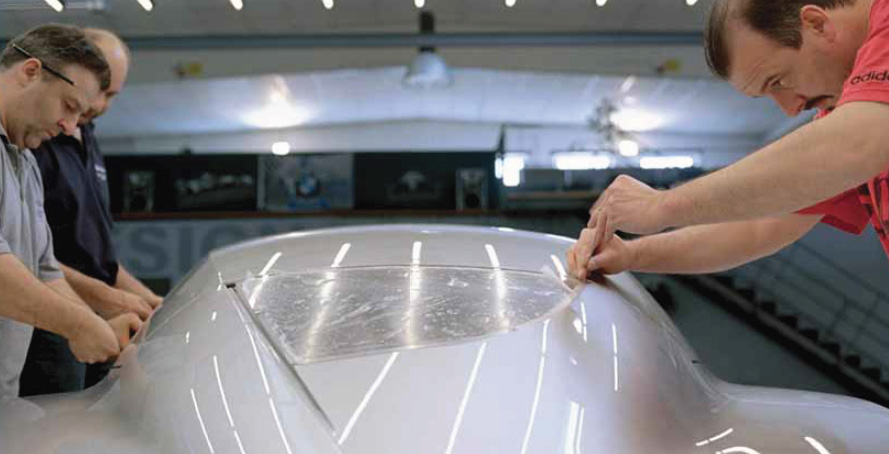
Composites represent a paradigm shift in materials technology for a new generation of automotive manufacturing engineers. AMS looks at the current and future challenges
Composite materials provide a number of manufacturing challenges for production engineers more familiar with processing metal parts. Making the transition from metals to composites is no simple matter, as a completely different set of rules apply. Unlike metals, the methods for successful composites machining are not well documented. But some basic insights into the materials and processes can help in understanding how best to handle these extremely tough, yet in some ways fragile, materials.
For automotive uses, composites can be divided into two camps: polymer matrix composites for interior and body components (by far the most prevalent group); and metal matrix composites, which are growing in popularity for parts such as brake rotors and cylinder liners.
 For instance, beginning with polymer matrix composites such as carbon fibre reinforced plastic (CFRP), it is not suitable to deploy conventional machining centres, a fact recognised by a growing number of machine suppliers. A case in point is CMS of Italy, which now offers a range of three- and five-axis machining centres suited to applications such as machining CFRP body and interior automotive components. Special features of CMS machines for these tasks include: enclosures designed for dust and noise containment; high-level electrical protection against carbon fibre dust; special vision panels to protect against carbon fibre dust abrasion; and a CNC-controlled dust extractor on the Y-axis to accommodate varying lengths of cutting tools. According to Graeme Cartwright, Sales Manager of CMS Group in the UK, automotive and motorsport customers involved in the use of CMS technology for composites machining include Lola Composites, the Advanced Composites Group and Atlas Composites.
For instance, beginning with polymer matrix composites such as carbon fibre reinforced plastic (CFRP), it is not suitable to deploy conventional machining centres, a fact recognised by a growing number of machine suppliers. A case in point is CMS of Italy, which now offers a range of three- and five-axis machining centres suited to applications such as machining CFRP body and interior automotive components. Special features of CMS machines for these tasks include: enclosures designed for dust and noise containment; high-level electrical protection against carbon fibre dust; special vision panels to protect against carbon fibre dust abrasion; and a CNC-controlled dust extractor on the Y-axis to accommodate varying lengths of cutting tools. According to Graeme Cartwright, Sales Manager of CMS Group in the UK, automotive and motorsport customers involved in the use of CMS technology for composites machining include Lola Composites, the Advanced Composites Group and Atlas Composites.
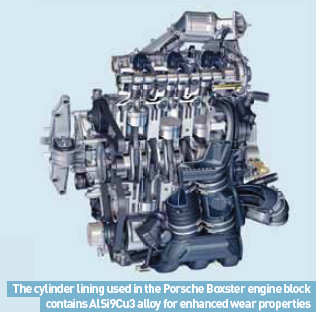 Metal matrix composites (MMC) have been subjected to extensive research and development over the past 30 years. MMCs are growing in popularity with designers because of their high strength, stiffness, and fatigue and wear resistance. Documented automotive applications in recent years include brake rotors and engine exhaust valves for the Toyota Altezza, driveshafts for the Chevrolet Corvette and cylinder liners for Honda and Porsche.
Metal matrix composites (MMC) have been subjected to extensive research and development over the past 30 years. MMCs are growing in popularity with designers because of their high strength, stiffness, and fatigue and wear resistance. Documented automotive applications in recent years include brake rotors and engine exhaust valves for the Toyota Altezza, driveshafts for the Chevrolet Corvette and cylinder liners for Honda and Porsche.
The cylinder liner used in the Porsche Boxster engine block was developed in conjunction with Kolbenschmidt, and made by selectively reinforcing the crank case, consisting of AlSi9Cu3 alloy, which is produced with pre-forms containing 25 per cent silicon (made by CeramTec), in combination with a special squeeze-casting technique. A similar component used in the Honda Prelude was made from MMC, featuring 12 per cent Al2O3 for enhanced wear properties and nine per cent graphite for added lubricity. However, one of the reasons often put forward for not using MMCs is the perception of poor machining characteristics in comparison to monolithic alloys. As most engineering components need a fi nal machining operation this has seriously hindered the use of MMCs. In reality, MMCs are readily machinable. Generally, they form short cutting chips and cutting forces are moderate.
The main problem is that the hard abrasive reinforcement in most MMCs cause rapid tool wear during machining that can lead to high machining costs. In the case of a given tool and set of cutting parameters, the abrasive wear of the tool will depend on the morphology, distribution, volume fraction and properties of the reinforcement phase in the composite.
Tool wear can be minimised, however, by selecting the most suitable grade of coarse-grained PCD tools, which give the best resistance to abrasive wear. High feed rates and depths of cut with copious lubrication are recommended for minimising tool wear during rough machining operations. Other machining processes, such as EDM, laser cutting and abrasive water-jet cutting, can also be used to machine MMCs
Tools for the job
New cutting tools are becoming available that are designed specifically for the rigours of composites machining. Careful use of the right tools, as with any material, makes a significant difference. The very nature of CFRP results in the generation of high cutting forces when undertaking machining operations that can lead to delamination. To overcome this, SGS Carbide Tool has been working on a new development called Series 20-CCR: a 12-flute range of routers for machining composite materials that not only overcomes these issues, it provides a better cut edge.
“It is essentially an end mill and profiling tool that will also plunge to produce holes and pockets,” explains David Cawkwell, UK Sales Manager of SGS Carbide. “The secret behind its success lies in the shallow helix which reduces the cutting forces that lead to delamination.”
Other end mills for the composites machining market include the new Cyber Series 2111 and 2102 from Industrial Tooling Corporation. According to ITC, the cutters have already delivered good results with productivity improvements, extended tool life and enhanced quality on graphite, metal matrix composites, Kevlar, carbon fibre and other abrasive materials.
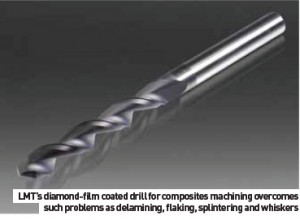 The new two-flute 2111 Series is a high-performance PCD end mill with a solid carbide shank and necking for extra reach, while the 2102 Series ball-nosed end mill with solid carbide shank and PCD-brazed tips offers enhanced tool life and extended productivity when machining abrasive materials. Due to the various kinds of CFRP available, drilling tools also have numerous requirements to satisfy, as Ingo von Puttkamer, sales manager at Gühring in Germany explains. “CFRP materials with different characteristics require special modifications to cutting tool geometries,” he says. “Coolant capabilities and machine rigidity must also be considered. This is why Gühring drilling tools supplied for CFRP applications are made from carbide with different coatings or PCD.”
The new two-flute 2111 Series is a high-performance PCD end mill with a solid carbide shank and necking for extra reach, while the 2102 Series ball-nosed end mill with solid carbide shank and PCD-brazed tips offers enhanced tool life and extended productivity when machining abrasive materials. Due to the various kinds of CFRP available, drilling tools also have numerous requirements to satisfy, as Ingo von Puttkamer, sales manager at Gühring in Germany explains. “CFRP materials with different characteristics require special modifications to cutting tool geometries,” he says. “Coolant capabilities and machine rigidity must also be considered. This is why Gühring drilling tools supplied for CFRP applications are made from carbide with different coatings or PCD.”
Gühring PCD drill/countersink tools are widely used on automatic drilling machines demonstrating high cutting data to reduce machining time. Where more complex geometries are a necessity, carbide tools are used and, in the case of stack materials (depending on layer thickness), diamond coatings are deployed.
 Reducing friction
Reducing friction
Kennametal has also been developing drills for CFRP applications, recently introducing its SPF (Split Point Fibre) drill, claimed to offer a burr-free and delamination-free cutting process throughout its entire operational life. The SPF drill features a carbide substrate, positive geometry and a smooth CVD multi-layer diamond coating, offering greater wear resistance and reduced friction, which increases tool life and improves chip flow. Special point thinning increases centering capability and allows reduced thrust, which in turn improves hole quality. SPF is viewed as a more cost-effective alternative to PCD drills, in particular for CFRP materials drilled on CNC machines. According to Kennametal, compared with PCD drills, SPF achieves (on average) double the tool life before any delamination appears at the hole exit.
“In field tests, the Kennametal SPF drill has drilled as many as 300 holes in the most difficult-to-machine CFRP grades without delamination, and as many as 1,000 holes without delamination in other grades,” says Marcelo Campos, Kennametal’s product manager for hole making. Contrary to PCD, the smooth diamond coating on the SPF drill does not have any metallic binder phases, resulting in increased wear resistance and reduced adhesion tendency, giving longer tool life and improved chip flow. The materialspecific front and chisel edge design gives increased selfcentring capability and reduced feed forces, contributing to improved hole quality and less delamination. SPF drills are available, as standard, in diameter ranges from 0.098 to 0.500 inch, short (K531A) or long (K532A), and in the metric range from 3.2mm to 6.50mm short (B531A) and 5.1mm to 5.35mm long (B532A). “We also have the ability to produce custom solutions, manufacturing drills as long as seven times diameter in some instances,” says Campos.
Elsewhere, the Onsrud Division of LMT Fette has developed a diamond-coated parabolic drill suitable for drilling both carbon fibre and carbon graphite materials. The new drill overcomes problems such as delaminating, flaking, splintering and whiskering, caused by the highly abrasive nature of the materials. The design of the drill also reduces thrust forces, returning more manageable chip formation, improved centering and faster penetration rates. The profile of the parabolic flute form drill improves swarf evacuation and resistance to wear and abrasion through a combination of tool geometry and the multi-layer nanocrystalline, six-micron diamond coating. The drill has a 30 per cent web thickness, against the conventional 12 to 15 per cent, adding both strength and rigidity.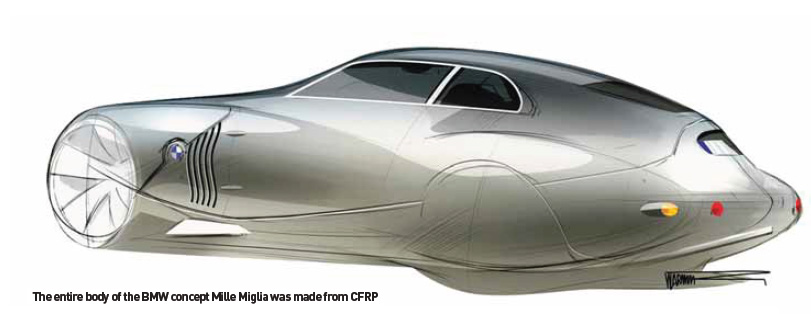
Under cutting conditions, the flute re-distributes mass to the outer cross-sectional area of the tool’s construction and because of the greater helix angle of 36 degrees to 40 degrees (instead of the typical 28 degrees to 32 degrees), a significant increase in the shearing action of the cut is achieved. The drill features a ‘modified’ split point with a positive rake at its apex that has the advantage of reducing the thrust under cut. Centering is also improved, while penetration rates can be increased with better chip formation and evacuation from the cutting zone, aided by the lower co-efficient of friction (0.15 to 0.2) of the coating. LMT says that cutting trials have demonstrated an ideal speed of 75m/min to maintain the best surface finish on both carbon fibre and carbon graphite materials, with applied feed rates of 0.075mm/rev.
Recently upgraded to deliver improved mechanical and acoustic properties, SymaLITE from Quadrant Plastic Composites has been specified by Tier One supplier Takeo for under-body shields for the new BMW M3. These lightweight panels cover almost the entire underside of the car, offering optimised aerodynamics for improved vehicle handling and fuel efficiency.
SymaLITE is a lightweight composite material based on polypropylene (PP) and orientated glass fibres, providing a balance of weight, rigidity and shape. The pre-orientated fi bres of SymaLITE allow good loft behaviour during the heating and moulding process, giving expansion of up to six times its original thickness and achieving densities of only 0.3g/cm³, while increasing bending stiffness in the z-direction. According to Karl-Heinz Kalmbach, Business Line Exterior and Structures Leader at Quadrant Plastics Composites, “SymaLITE technology allows for physical and mechanical properties to match the demands of the part by varying the mix of PP and glass fibres. This offers a new level of design and processing flexibility. For example, it accommodates fl at part design without the corrugations usual to parts moulded in GMT and LFT, thereby giving better aerodynamics and acoustics damping characteristics.”
The new BMW application for which SymaLITE is specified includes engine shield, gearbox shield and under-body shields, to which it brings weight savings, improved acoustic performance, better aerodynamics, corrosion resistance and safety due to the material’s high resistance to crack propagation and deformation. BMW has been exploring the use of composites for a number of years. For example, in 2006 the entire body of the Mille Miglia concept coupe was clothed in CFRP.
From art to part
CAM software is also crucial in the manufacture of polymer composite parts. Delcam, for example, has been actively involved in the composites market for a number of years. The company’s software for pattern makers has a number of synergies with composites and many of its latest developments are based on these routines.
Delcam’s pattern-making functionality, such as wire cutting of foam, can remove huge quantities of bulk material using hot wire. The result is massive time savings for roughing operations. The company’s marketing manager, Peter Dickin, says that Delcam customers who use composites include Team Roberts Moto GP team, which uses PowerMill to drill and trim composite parts, and UK-based Visioneering, which used PowerMill to produce the carbon fibre-reinforced body and under-floor for the JCB Dieselmax car, which recently set a new landspeed record for diesel vehicles. Motorsport supplier Crosby Composites is also an advocate of Delcam. The Brackley, UK company is using new Delcam technology to finish machine CFRP parts to tolerances between 0.1 and 0.25mm.
“Many composite components are only made to approximate sizes and then trimmed to their final size manually during assembly,” says Dickin. “This process is both time consuming and inaccurate. We believe that composite manufacturers must be able to produce parts to similar levels of accuracy as suppliers of metal components before the materials can hope to achieve their true market potential.” One of the chief problems with polymer matrix composites is that machined holes and pockets tend to be undersize because the material ‘relaxes’ when it is cut. This effect is difficult to predict because it is impossible to cut all the fibres in the same orientation.
With the Delcam process, the initial machining operation on the component is followed by an inspection using a probe on the machine tool working with the company’s PowerINSPECT on-machine verification software. This system reports how much additional material needs to be removed, therefore enabling the required extra tool paths to be generated in Delcam’s PowerMILL CAM system. For a typical component at Crosby Composites, featuring between 20 and 30 holes, a further cycle of inspection and machining may be needed to produce all the dimensions to the required tolerance. However, for subsequent parts, the complete machining sequence can be repeated and the results checked with a final inspection.
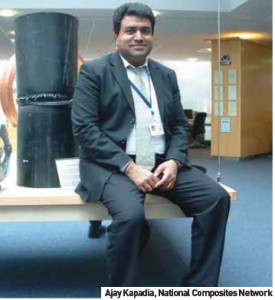 Single fixture allows for machining and inspection
Single fixture allows for machining and inspection
Another benefit of this system is that all the machining and inspection can be completed on the machine tool using a single fixture. According to Paul Crosby, owner of Crosby Composites, it is impossible to maintain the necessary tolerances when moving between a series of fixtures, while using multiple ups on different fixtures would also take much longer.
Using the Delcam system, the first set of 17 components produced by Crosby Composites for a Formula One customer fitted the car with no clashes or rework. It was the first time in the team’s history that this had happened with any set of composite parts from any supplier. “The early success we have seen with this new approach has made us confident that it can be used for many other applications where high accuracy composite components are needed, especially in the automotive industry,” says Dickin The processing of composites presents far more challenges than just those associated with machining. Tape laying and fibre placement are also central to the production of polymer composite parts, and it’s in these two areas that MAG Cincinnati is already demonstrating a strong record of success.
Offering what MAG Cincinnati’s European sales manager Julian Frankland calls “machine tools of the future”, material lay-up rates can be increased to more than 60kg/hour using automated methods, in comparison with traditional manual methods providing lay-up rates of around 1.5kg/hour. Automation also offers the ability to condense several parts into a single, more cost-effective component, which is perhaps one of the reasons why the company has already sold 51 flat/contour tape layers around the world.
Expert help is at hand
There is little doubt that the demand for composite materials and the associated production machinery is growing; a fact that can be confirmed by the UK’s National Composites Network, which is seeing an increasing number of enquiries from automotive engineers seeking advice about composites. Launched in 2004, NCN was the first knowledge transfer network established by the Technology Strategy Board and forms part of the broader Materials KTN. The NCN offers four stages of help and advice. The first port of call is the national helpdesk, where answers to straightforward questions are answered. The next is expert consultation, and typically entails a telephone conversation with an industry expert in the required field. Stage three is a technology audit, where an expert will normally spend a day on site, assessing the problems and challenges and drawing up a report proposing a feasibility study.
“The fourth stage is more involved, whereby a certain amount of accountability must be demonstrated,” explains Ajay Kapadia, programme director at NCN, based near Cambridge, UK. “For instance, the benefiting firm has to agree, in principle, to the intended outcomes stated in the proposal. That is, if the actions are implemented, which could for instance involve technology transfer, supply chain development or training programmes, that they will lead to the creation of a certain number of new jobs, increase turnover by a certain percentage or improve export figures – that kind of thing. In effect, it represents a ‘payment in kind’ from the beneficiary firm.
“The feasibility study stage requires an expert to be present on site for a number of days,” he continues. “A review is conducted two years later to see if the targets have been met, the results of which are fed back to central government so they can see what return is being achieved on their investment,” he explains. “The majority of automotive engineers who call need help with design and/or production-related issues, although tooling and testing are other common areas of enquiry,” Kapadia adds.
It seems that widescale use of composites has been just over the horizon going on 10 years now. Yet the realisation of their potential has been slow, primarily because of cost. The composites industry is making strides, however, in developing materials and processes that make highly functional parts at a more reasonable cost. This trend is significant for automotive manufacturing engineers who increasingly will find themselves machining materials that contain little or no metal at all.


































